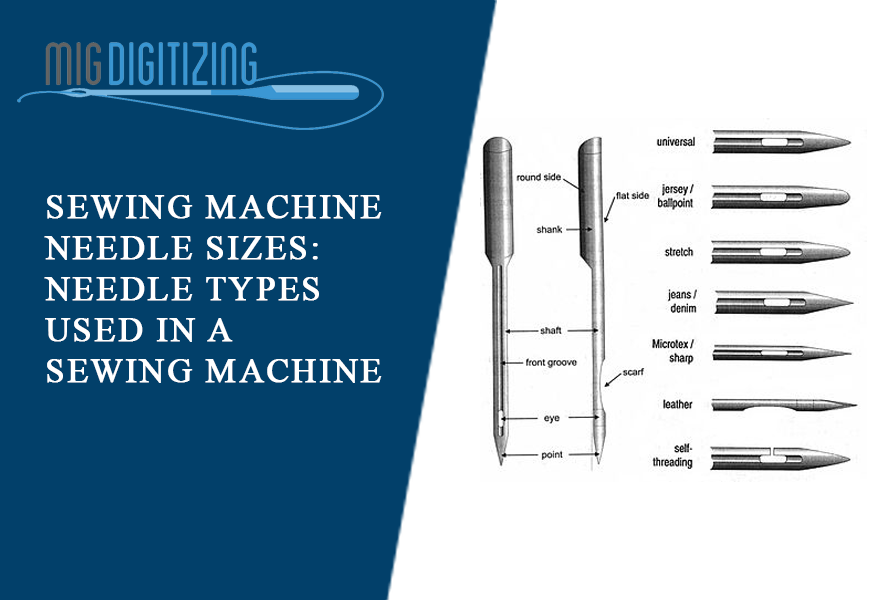
Sewing Machine Needle Sizes: Needle Types Used In A Sewing Machine
At what point does one believe in sewing machine needles and about changing them from what you bought from the showroom?
It is time to start out the stitching, and therefore the common stitches you'll fiddle with are:
-
Dropped stitches
-
Skipped stitches
-
Uneven seams
-
Needle plate damage
-
Damaged fabrics thanks to snagged threads.
All the above problems are often the result of either using the incorrect, unsuitable needle or wiping out or damaged needles.
There are many sorts of stitching machine needles available. Choosing the simplest one for your project depends on many things like:
-
The technique you're using.
-
The thread used for the project.
-
The type of cloth.
Some machines will have a label on their body, indicating the sort of needle it takes. The stitching machine manual you bought once you purchased the machine can also guide you during which needle to settle on.
How often should I modify the needle?
Blunt needles are the bane of lovely fabric, especially delicate ones. A blunt needle will catch on the material, snagging it whenever it pierces it.
Even if you do not want to vary the needle. That's an honest indication to seem out for.
If you discover that the needle is leaving large marks on the material, you'll have to change it and use a smaller needle.
Now let's take a look at the needles.
Sewing Machine Needle sizes
In selecting the stitching machine needle, you would like to understand the acceptable number for the material you're sewing. Basically, the thicker the needle, the larger the amount. Finer the material, lower the amount of the needle.
This is often the American numeration system.
Machine Embroidery Needles
The attention of this needle is greater to accommodate thicker embroidery thread. They work alright with all kinds of materials.
Nowadays, you get Titanium needles to try to do machine embroidery.
General-Purpose Needles
These are because the name says, needles you'll use with most materials like wovens and knits. These are available in many sizes. it's classified consistent with the load of the material. A universal needle is analogous to a pointy needle but features a slightly rounded tip.
Wing Needles
These are needles with a special wide shape (reach sides which appear as if wings). they're want to create holes within the fabric while stitching. It's of great use in heirloom sewing and makes the material appear as if you've got done pulled thread embroidery.
Ball Point Needles
Stretch needles even have a coating on them which make stitching smooth. Stretch needles are meant for extra stretchy fabrics, and Jersey needles are meant for medium stretch fabrics. These needles have a blunt tip that slides between the threads of your fabric rather than piercing them.
Twin needles
This needle makes two rows of sewing lines parallel to every other. you would like two spools of thread fixed on spool pins for this needle to figure within the package for twin needles there'll be variety given – this is often the space between the 2 shafts of the needle, indicating the difference between stitches. This is often a special quiet needle with two shafts fixed on a bar and one shank. This needle makes two rows of sewing lines parallel to every other. You would like two spools of thread fixed on spool pins for this needle to figure.
Jeans needles
These are sharp and thick needles with a thick shaft meant to stitch denim and other heavy materials like canvas, twill. This is often also an excellent needle to use if you've got to stitch several layers of cloth together. You'll also use universal needles of size 16- 18 as an alternate.
Sharp needles / Microtex needles
This needle will offer you perfect straight stitches. You'll use these needles for even very heavy fabrics like leather canvas etc. They're specifically meant for woven fabrics like cotton and are excellent for topstitching.
Stick with universal needles. It's a secure bet. You'll sew both wovens and knits reasonably well with them. Just remember to vary often. don't try using the sharp needles for knits or use the ballpoint needles for woven cloths.
Leather Needles
his needle shouldn't be wont to sew synthetic leather or suede. You would like to use an extended stitch length with this needle, as you'd not want too close holes in your leather. These are needles with a wedge that can easily penetrate leather and suede.
Conclusion
These are the most common needle sizes. If you need any advice or help about the topic or anything related to custom embroidery digitizing, feel free to take our help at Migdigitizing.



